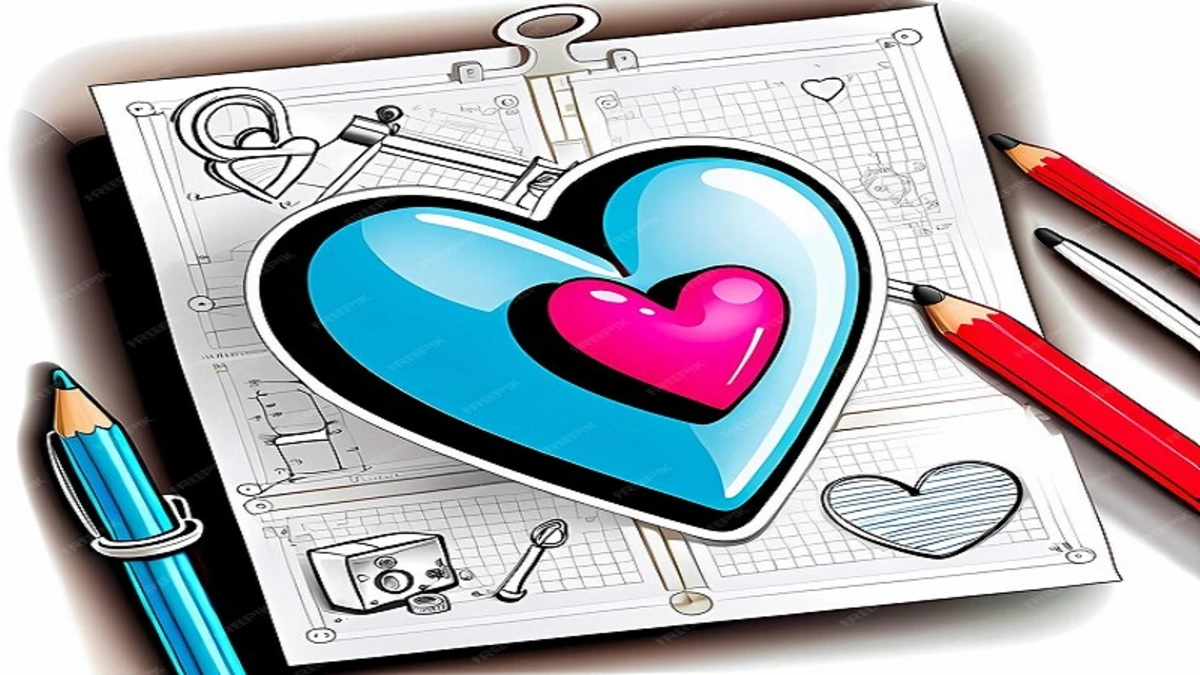The Art of drawing:yw-tzomiaao= heart: A Comprehensive Guide
drawing:yw-tzomiaao= heart is a timeless form of expression, and when it comes to symbols that resonate universally, the heart takes center stage. Whether you’re an aspiring artist, a casual doodler, or someone looking to add a personal touch to your creations, mastering the art of drawing:yw-tzomiaao= heart can open up a world of creativity. In this guide, we’ll explore everything from the basics of heart shapes to advanced techniques for adding depth and emotion to your artwork.
Understanding the Heart Shape
The Basics of the Heart Shape

At first glance, the heart shape seems simple—two rounded lobes on top and a pointed bottom. However, there’s much more to it than meets the eye. The heart symbol is rich in history and meaning and is often associated with love and affection. When you start drawing:yw-tzomiaao= heart, it’s essential to understand the foundational shape.
Start with a simple outline. Draw two circles for the top lobes, then extend downward to create a point at the bottom. You can refine this shape by smoothing the curves and ensuring symmetry. This foundational step is crucial for creating various styles of hearts later on.
Variations of the Heart Shape
Once you’re comfortable with the basic heart shape, it’s time to explore its variations. Hearts can take on different forms, from traditional to modern interpretations. For instance, you might try a more elongated heart for a romantic feel or a cartoonish version with exaggerated features.
You can also play with the thickness of the lines. A thick, bold heart can evoke strength and passion, while a delicate, thin outline may convey gentleness and tenderness. Experimenting with these variations allows you to express different emotions through your art.
The Symbolism Behind Hearts
Hearts are more than just shapes; they carry deep meanings. In many cultures, the heart symbolizes love, compassion, and connection. When you draw a heart, you’re not just creating a pretty picture; you’re tapping into a powerful symbol that resonates with people on an emotional level.
Consider the context in which you’re using the heart. Is it for a romantic card, a friendly note, or perhaps a piece of social commentary? Understanding the symbolism behind hearts can enhance your drawing:yw-tzomiaao= heart and the message you want to convey.
Techniques for drawing:yw-tzomiaao= heart
Basic Techniques for Beginners
If you’re just starting, keep your heart drawing:yw-tzomiaao= heart simple. Begin by sketching lightly with a pencil to outline the basic shape. This allows you to make adjustments without the pressure of committing to ink right away. Once you’re satisfied with the shape, you can go over it with a pen or marker.
Another technique is to practice drawing:yw-tzomiaao= heart in different orientations. Turn your paper and draw upside down or at angles. This practice helps you become more comfortable with the shape and can lead to creative variations in your artwork.
Advanced Techniques for Depth and Texture
Once you’ve mastered the basic heart shape, you can experiment with adding depth and texture. Techniques like shading can give your heart a three-dimensional appearance. Use a pencil to create gradients; the darker the shading, the more pronounced the depth.
Additionally, consider incorporating patterns or textures within the heart itself. Dots, stripes, or floral designs can transform a simple heart into a unique piece of art. This not only enhances the visual appeal but also adds a personal touch to your work.
Color Theory and Its Application
Color plays a vital role in drawing:yw-tzomiaao= heart. Each color carries its emotional weight—red for love, blue for tranquility, green for growth. When selecting colors for your heart drawings, think about the message you want to convey.
Experiment with color combinations to see how they interact. You might use complementary colors for a striking effect or analogous colors for a more harmonious feel. The application of color can dramatically change the tone of your artwork, making it essential to consider in your creative process.
Creative Uses for Heart drawing:yw-tzomiaao= heart
Greeting Cards and Invitations
One of the most common uses for heart drawing:yw-tzomiaao= heart is in greeting cards and invitations. Whether it’s for Valentine’s Day, a birthday, or a wedding, hearts can add a personal touch to your designs. You can hand-draw hearts or use them as part of a digital design.
Consider the style of the card you’re creating. A playful, whimsical heart might be perfect for a child’s birthday invitation, while a sleek, elegant heart can set the tone for a wedding invitation. Your heart drawing:yw-tzomiaao= heart can become the focal point or a subtle background element, depending on your vision.
Wall Art and Decor
Hearts can also serve as beautiful wall art. Whether you’re decorating your own space or creating a gift for someone else, heart drawing:yw-tzomiaao= heart can be a heartfelt addition. Consider creating a series of heart illustrations that tell a story or convey a theme.
You might experiment with different materials, such as watercolor, acrylic, or mixed media, to create a unique piece. A gallery wall featuring various heart drawing:yw-tzomiaao= heart can become a conversation starter and a reminder of love and connection.
Incorporating Hearts into Personal Projects
Hearts can find their way into a variety of personal projects, from scrapbooking to digital art. They can serve as embellishments, backgrounds, or central elements in your designs. Don’t be afraid to think outside the box—hearts can be integrated into logos, websites, and even social media graphics.
If you’re working on a personal project, consider the message you want to communicate. How can your drawing:yw-tzomiaao= heart enhance that message? This approach ensures that your art remains meaningful and connected to your overall vision.
Tips for Enhancing Your Heart drawing:yw-tzomiaao= heart
Practicing Regularly
Like any skill, drawing:yw-tzomiaao= heart requires practice. Set aside time each week to work on your heart drawings. This can be as simple as doodling during your lunch break or dedicating an evening to more detailed work. The more you practice, the more your style will develop.
Consider keeping a sketchbook dedicated to heart drawings. This allows you to track your progress and experiment with different styles and techniques over time. You might even discover your unique voice as an artist through this focused practice.
Seeking Inspiration
Inspiration can come from various sources. Look at other artists’ work, explore online galleries, or even observe the world around you. Nature, architecture, and everyday objects can spark ideas for heart designs.
Don’t hesitate to draw inspiration from other cultures and traditions as well. Different cultures have their interpretations of hearts, which can enrich your understanding and approach. This diversity can lead to innovative heart designs that resonate with a broader audience.
Joining Art Communities
Connecting with other artists can be incredibly beneficial for your growth. Consider joining online art communities or local art groups. These spaces provide opportunities for feedback, collaboration, and inspiration.
Sharing your heart drawings and receiving constructive criticism can help you refine your skills. Moreover, engaging with other artists can motivate you to push your boundaries and explore new techniques you may not have considered before.
Conclusion
Drawing hearts is more than just a simple artistic endeavor; it’s an exploration of emotions, symbols, and creativity. From mastering the basic shape to experimenting with textures, colors, and meanings, the journey of drawing hearts offers endless possibilities. As you continue to hone your skills, remember that each heart you draw is a reflection of your unique perspective and emotional depth.
So grab your sketchbook, unleash your creativity, and let your heart guide your hand. Whether it’s a simple doodle or an elaborate piece of art, the world of heart drawing awaits you, ready to be explored and enjoyed.



